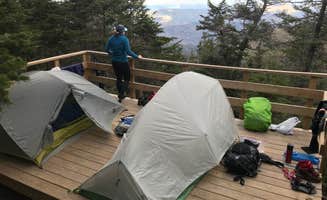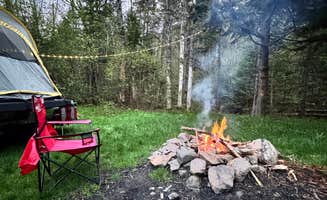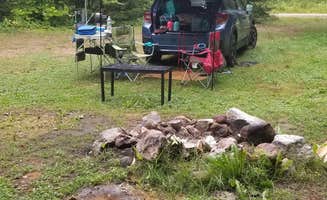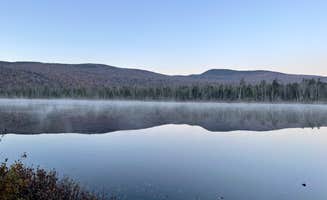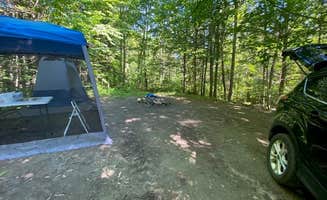Dispersed camping near White Mountain National Forest provides access to over 800,000 acres of wilderness spanning New Hampshire and Maine. Elevations range from 1,000 feet in the valleys to 6,288 feet at Mount Washington's summit, creating diverse camping environments. Most primitive sites are situated along unpaved forest roads that become impassable during spring mud season, typically from late March through mid-May.
What to do
Hiking Twin Mountains: Access multiple trails from the North Twin Trailhead at the end of Haystack Road. "It is next to the Highway on a paved fire road. So you can hear traffic. And it is paved (which is good if it's wet and muddy elsewhere). The other spots looked amazing," notes Drew.
Swimming in local waterways: Town Hall Road Dispersed sites offer water access. "We found our spot which had some river access and it was gorgeous. It had an above and below spot which hosted our two tents," says Alex S. Many campers use these spots for cooling off during summer months when temperatures can reach the 80s.
Fishing opportunities: Elbow Pond Recreation Area provides both camping and fishing. "Theres a nice pond with great views and good fishing. Some of the sites are close together but there are some that are a good distance apart," explains Dom L.
Stargazing: The remote location of many dispersed sites creates excellent night sky viewing. "We enjoyed a spectacular view of the Blood Super Moon from the campsite. Overall the site was open to the sky near the road yet protected from the wind," reports Kevin C. about Cherry Mountain Road.
What campers like
Privacy between sites: Town Hall Road Dispersed offers well-separated camping areas. "We loved this spot. There were plenty of sites to choose from and most (not all) had access to the river as well as a fire ring. Sites were on a dirt road, but it was quiet for the most part. Sites were also a good distance from each other so it felt pretty private," shares Josie W.
Campsite variety: Cherry Mountain Road provides different types of sites. "We stayed on site #5 because it was flat, sunny, grassy and had a little brook. Had some passing by traffic but each site is far apart from each other," mentions Aimee L.
Quiet atmosphere: White Mountains Camping on Little Larry Road delivers peaceful surroundings. "These campsites are located on a dead end dirt road. The campsites are spread out so you are not on top of each other (I think there are only 8 sites on the road.) The site at the very top of the road is huge and has a nice stream," reports Rhonda H.
Base for multiple adventures: Tripoli Road serves as a central point for exploring the region. "This is a great spot to start getting into camping with less amenities and more outdoors. Drive up the dirt road and find a nice riverside camp site. 3 miles of seclusion if you want. Great hiking trails directly off Tripoli," notes Joseph A.
What you should know
Wildlife precautions: Bear activity requires proper food storage. "You may see moose or bears in the area," warns Jean C. about Haystack Road. Another camper adds that at Little Larry Road, "Upper two top sites beware of bears especially the right side site. Game trail heaven."
Road conditions: Some sites require high-clearance vehicles. "The road in is pretty rough and is not recommended for sedans or lower riding cars," cautions Dom L. about Elbow Pond Recreation Area. Similarly, sites along Tripoli Road may need "vehicles with decent clearance."
Limited facilities: Guyot Shelter offers minimal amenities in backcountry settings. "This is a classic AMC shelter in the backcountry of the white mountains. Though be aware that the hut itself fills up quick and it only 3 sided so its still probably a good idea to bring a tent. There is a small stream to pump water from but it is seasonal," advises Asher K.
Campsite security: Some campers report issues with theft. "Quiet area not far from the main road and a bunch of trailheads, but beware of people stealing camping gear. I left out gear to claim a spot while out hiking and came back to people having stolen some of it," warns Sean L.
Tips for camping with families
Select sites with water access: Sites with streams provide both recreation and practical water use. "Fantastic secluded options, highly recommend getting a good spot by the river. Park staff are great and spots are well maintained," recommends Kat B. about Tripoli Road.
Consider proximity to facilities: Some family-friendly options have basic amenities. "Has a nice shelter, spring, privy, platforms, some sites have somewhat of a view of far away mountain tops," notes Sean F. about Guyot Shelter, though reaching this site requires significant hiking.
Plan for weather variations: Mountain weather changes rapidly, with temperature swings of 30+ degrees possible in a single day. "It was a great place for Rainy Camping. We went during a pouring rain storm and our site remained relatively dry. We even enjoyed a small fire the next day," shares Rowan E. about Town Hall Road.
Tips from RVers
Size limitations for dispersed sites: Most primitive camping areas accommodate only smaller RVs. "There are a string of tent sites on either side of the road with some right up to the intersection with Cherry Mountain trail. A few were small and could just fit a tent and a car, where some offered more space," observes Justin P.
Finding level parking: Hogan Road Pulloff provides limited but accessible spots. "About 1km (.6 miles) of gravel road, easy enough for a big road bike, but don't go any further as it gets rough. Plenty of trees to hang your hammock. Enough space to put up to 3-5 tents," explains Dominique F.
Consider connectivity needs: Some sites offer better cellular service than others. "If all we needed was a campsite with no solar or starlink, this would be 5 star review. Lots of options, great hiking in the area. But if you need solar or starlink, there's only 1 or 2 viable spots," mentions Rebecca B. about Town Hall Road.


